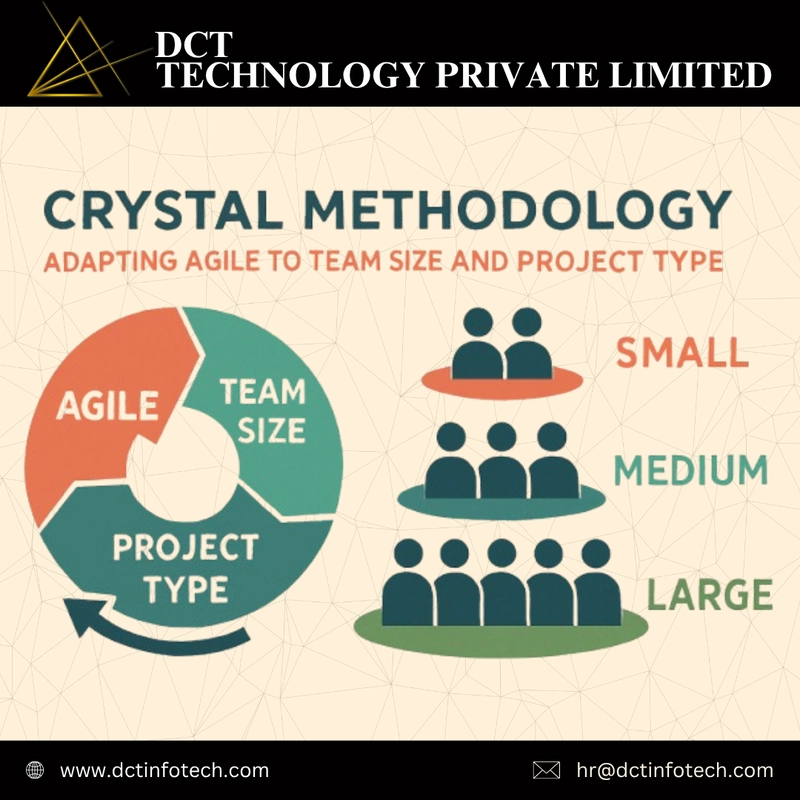Crystal Methodology: Adapting Agile to Team Size and Project Type
If you think Agile is a one-size-fits-all solution, think again.
Many teams adopt Scrum or Kanban without realizing that team size, criticality, and project complexity should influence how you work—not just blindly follow ceremonies.
That’s where Crystal Methodology shines.
Crystal is a lightweight, adaptive Agile framework that evolves based on your team’s context. It doesn’t force daily standups, sprints, or rigid roles. Instead, it encourages human-powered, communication-first development tailored to what your project really needs.
🧠 Why Developers Should Care About Crystal
- Traditional Agile frameworks assume teams of 5–9 members. But what if you’re just 3 devs? Or 30?
- Crystal helps you choose the right practices for your team size and project criticality.
- It values people and interactions over rigid processes (a nod to Agile Manifesto).
🔎 Here’s a breakdown of how Crystal adapts based on team and project needs:
- Crystal Clear → For teams of 1–6 people working on low-criticality apps (like a startup MVP or internal tool)
- Crystal Yellow / Orange / Red → For larger teams or higher risk projects (like banking or healthcare apps)
📌 This scaling flexibility makes Crystal a great choice for consultancies, startups, or hybrid teams juggling multiple projects.
⚙️ Key Principles That Set Crystal Apart
-
Frequent Delivery
Short cycles, delivering working code often.
Pro tip: Use tools like Vercel Preview Deployments to demo features early.
-
Reflective Improvement
After every delivery cycle, reflect. What went well? What didn’t? Then adapt.
No forced retrospectives—just thoughtful feedback loops. -
Osmotic Communication
Sitting together (or being constantly connected virtually) allows information to “flow” effortlessly.
If remote, use Slack + Around Video for a similar effect. -
Personal Safety
Developers must feel safe to speak up, push back, or offer better solutions. -
Focus
Reduce context switching. Crystal emphasizes deep work and flow state. -
Technical Environment
Invest in tools that support quick builds, tests, and deploys.
Here’s a minimalDockerfileyou might use for local dev in a Crystal Clear environment:
FROM node:18
WORKDIR /app
COPY . .
RUN npm install
CMD ["npm", "run", "dev"]
👥 Real-World Application: Which Crystal Fits You?
Ask yourself:
- How many people are on your team?
- How critical is the system you’re building?
- Do you need regulatory compliance?
- How fast do you need to ship?
💡 Example:
You’re building a prototype for a fintech startup with 4 developers and 1 designer—Crystal Clear is perfect.
But if you’re building a health records system for a hospital with 20+ team members, Crystal Orange might be more appropriate.
🔄 Crystal vs. Scrum: It’s Not a Competition
Scrum might work great if you love ceremonies, roles, and strict sprint planning.
But if you’re a lean team moving fast, constantly evolving your process, and hate being boxed in—Crystal gives you room to breathe.
✅ There are no mandatory artifacts.
✅ You define your own team norms.
✅ You can adapt every cycle without overhauling the whole system.
If you’re looking for a full breakdown of Scrum vs. Crystal with examples, check this deep dive from Martin Fowler’s blog.
💬 Let’s Make This Interactive
💥 Have you tried Crystal in your projects?
💥 Do you think “contextual Agile” is the future?
💥 Are your clients open to these adaptable methods—or stuck on fixed plans?
Drop your experience or thoughts below 👇 I genuinely want to hear how different teams are working today.
👉 If you’re into smart, flexible project strategies, modern development tools, and real-world Agile insights, make sure to follow [DCT Technology] for more actionable content like this.
Let’s build smarter. Not just harder.
#agile #crystalmethodology #softwaredevelopment #scrum #startups #teammanagement #productivity #webdevelopment #itconsulting #projectmanagement #devcommunity #developers #devto


